Resetowanie twojego hasła WordPress jest zwykle prostym procesem. Czasami jednak standardowe metody nie działają, przez co twój dostęp do witryny internetowej jest zablokowany.
Niektórzy z naszych czytelników napotkali ten problem i poprosili nas o poradę dotyczącą najlepszego sposobu uzyskania dostępu do swoich kont. Na szczęście zawsze możesz użyć narzędzia phpMyAdmin w panelu sterowania twojego konta hostingowego, aby bezpośrednio zresetować hasło z bazy danych WordPress.
W tym artykule pokażemy, jak łatwo zresetować hasło WordPress z phpMyAdmin. Wyjaśnimy każdy krok w jasny sposób, zapewniając, że nawet jeśli nie jesteś zaznajomiony z bazami danych, możesz bezpiecznie podążać za nimi.
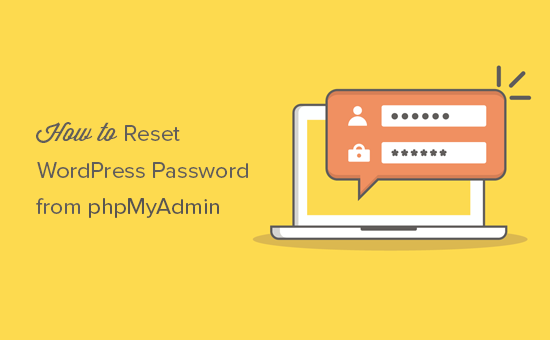
Dlaczego warto resetować hasło WordPress z phpMyAdmin?
WordPress umożliwia bardzo łatwe odzyskanie utraconego hasła.
Możesz po prostu przejść do ekranu logowania twojej witryny internetowej WordPress i kliknąć odnośnik “Zgubiłeś hasło?”.
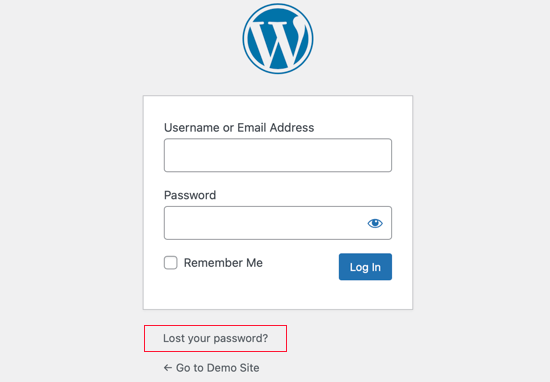
Po kliknięciu odnośnika zostaniesz przeniesiony na stronę resetowania hasła. Gdy wpiszesz swoją nazwę użytkownika lub adres e-mail, WordPress wyśle odnośnik do resetowania hasła na powiązany adres e-mail.
Jeśli jednak nie masz dostępu do tego adresu e-mail lub twoja witryna WordPress nie wysyła wiadomości e-mail, nie będziesz w stanie zresetować hasła.
W takiej sytuacji konieczne będzie zresetowanie twojego hasła do WordPressa bezpośrednio w bazie danych. Najprostszym sposobem na to jest użycie phpMyAdmin.
Powiedziawszy to, zobaczmy, jak łatwo zresetować hasło WordPress z phpMyAdmin.
Jak zresetować hasło WordPress z phpMyAdmin
Jeśli nie chcesz oglądać poradnika w formie filmu, możesz kontynuować czytanie poniższej wersji tekstowej.
Najpierw należy logować się do kokpitu cPanel twojego konta hostingowego WordPress. Następnie należy przejść do sekcji Bazy danych, gdzie należy kliknąć ikonkę phpMyAdmin.
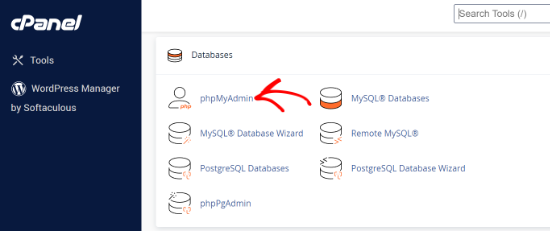
Spowoduje to uruchomienie aplikacji phpMyAdmin.
Tutaj musisz wybrać twoją bazę danych WordPress z lewego panelu.
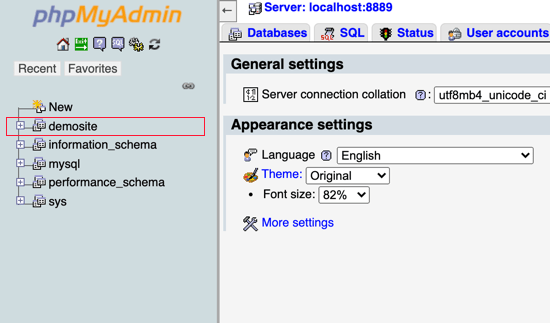
Zobaczysz teraz listę tabel w twojej bazie danych WordPress.
Na tej liście należy wyszukać tabelę wp_users i kliknąć znajdujący się obok niej odnośnik “Przeglądaj”.
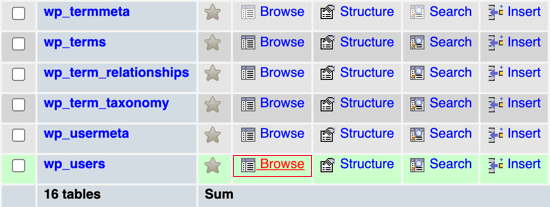
Uwaga: Nazwy tabel w twojej bazie danych WordPress mogą mieć inny prefiks niż ten, który pokazujemy na naszym zrzucie ekranu. Zmiana prefiksów tabel może poprawić zabezpieczenia twojej witryny WordPress.
Zobaczysz teraz wiersze w twojej tabeli użytkowników WordPress. Kliknij przycisk edycji obok nazwy użytkownika, którego hasło chcesz zmienić.
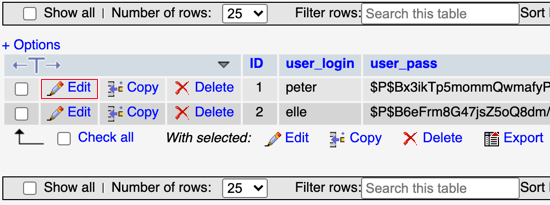
PhpMyAdmin wyświetli formularz ze wszystkimi polami informacji o użytkowniku.
Będziesz musiał usunąć wartość w polu user_pass i zastąpić ją twoim nowym hasłem. W kolumnie funkcji wybierz MD5 z menu rozwijanego, a następnie kliknij przycisk Przejdź u dołu formularza.
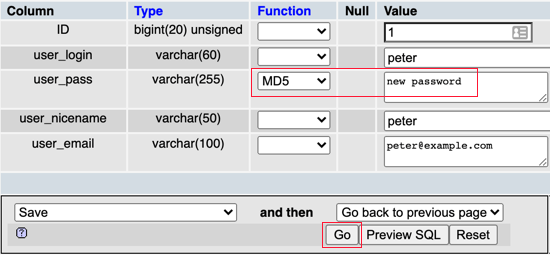
Twoje hasło zostanie zaszyfrowane przy użyciu skrótu MD5, a następnie zostanie zapisane w bazie danych.
Gratulacje! Udało ci się zmienić twoje hasło do WordPressa za pomocą phpMyAdmin.
Niektórzy z was mogą się zastanawiać, dlaczego wybraliśmy skrót MD5 do szyfrowania hasła. WordPress wcześniej używał skrótu MD5 do szyfrowania haseł, ale od wersji WordPress 2.5 używa silniejszych technologii szyfrowania.
Jednak WordPress nadal rozpoznaje MD5, aby zapewnić kompatybilność wsteczną. Gdy tylko użytkownik loguje się przy użyciu ciągu haseł przechowywanego jako skrót MD5, WordPress automatycznie zmieni go, aby korzystać z nowszych algorytmów szyfrowania.
Przewodniki ekspertów dotyczące haseł w WordPressie
Teraz, gdy już wiesz, jak zresetować hasło WordPress z phpMyAdmin, możesz zapoznać się z innymi artykułami związanymi z hasłami w WordPress.
- Jak zmienić twoje hasło w WordPress (przewodnik dla początkujących)
- Jak zresetować hasła wszystkich użytkowników w WordPress?
- Jak dostosować stronę resetowania hasła WordPress?
- Jak zmusić użytkowników do zmiany haseł w WordPress – Wygaśnięcie hasła
- Zapomniałeś hasła? Jak odzyskać utracone hasło w WordPress
- Jak wymusić silne hasła na użytkownikach w WordPress
- Jak dodać uwierzytelnianie dwuskładnikowe w WordPress (darmowa metoda)
- Jak zezwolić użytkownikom na ukrywanie/pokazywanie haseł na ekranie logowania do WordPressa?
- Jak łatwo i bezpiecznie zarządzać hasłami (przewodnik dla początkujących)
Mamy nadzieję, że ten poradnik pomógł ci dowiedzieć się, jak zresetować hasło WordPress z phpMyAdmin. Zachęcamy również do zapoznania się z naszym przewodnikiem krok po kroku po zabezpieczeniach WordPressa, który pomoże ci zadbać o bezpieczeństwo twojej witryny lub z naszą ekspercką listą niezbędnych wtyczek.
If you liked this article, then please subscribe to our YouTube Channel for WordPress video tutorials. You can also find us on Twitter and Facebook.





Graham
THANK YOU!!
I was caught up on the md5 encryption of the pw field. This really save my tail. I was using a member profile update which stripped all the email fields. This in turn also stripped mine and poof! Everyone’s password was deleted.
Seriously.
So, thank you a lot.
-Graham
Karen Seet
How do I find my “hosting provider” so I can get to phpmyadmin? I am new to this.
Muhammad Talha
Thanks a lot!
Edwin Calimlim
Great post, i wasn’t able to access my WP site for months already but thanks to this post, it is really a big help for me. Thank you.
atif shahab
Thanks alot. I was worried and stuck as well as i was unable to acess my WordPress dashboard for 2 hours. your recipe worked quickly. Thanks once again
WPBeginner Support
Glad it helped you solve the issue
Admin
Niculina
Thanks!! it worked! :):)
Joel
Lifesaver, thank you!
alan
What a fantastic email, new to C-panel but this tutorial was so clear I did it first time.
Great job.
Regards,
Alan
Trevor
Thank you !!!
Pedro
Did this now Jetpack gives me this error :
Jetpack could not contact WordPress.com: register_http_request_failed. This usually means something is incorrectly configured on your web host.
Operation timed out after 15000 milliseconds with 0 bytes received
Any tips on this?
Margie
Thank you so much. The instructions were easy enough for even me to follow
Carina
I wish it worked for me……I followed the directions [easy] but when I went to put in the MD5 hash numbers, they were exactly the same as what was already in the field value. This tells me that my problem is then not entering my user name and password that is the problem, but something completely different. …..:(
Thom Burlington
Thank you, but ..
while I can now reset the password with the MD5 code, derived from the new password I created, say, “abc” , and I finish and go back to my wordpress adimin signin:
domain.org/wp-admin : username ; password
for the password do I now use “abc” ?
Thom Burlington
Yes the password is “abc” – very nice – between your post and the video you are very clear, thank you.
Neal Kelshaw
Not quite correct. If you choose MD5 as the function in the drop down menu, and then type the password in plain text it hashes the value to an MD5 value.
tobi
awesome post thanks a lot
Jon O
Just wanted to say a BIG thank you for this article! I was indeed hacked and had sought assistance from my hosting company and others.. but this article was the only straight forward approach that worked first time! Thanks so much!
WPBeginner Support
Glad you found it helpful.
Admin
Tanya
I spent hours trying to find a website to explain why I was logged onto my WP then 5 minutes later I couldn’t log onto it again.
Thank you so much for the simple video. Problem solved in 5 minutes!
You rock!
WPBeginner Support
Glad you found it helpful.
Admin
Creina
Thank you. For anyone that finds the video confusing just follow the written instructions.
ashish
thank you so much for this tutorial…
Dairick
Thank you for this turorial
Parbat Devkota
thank you work charm.
Alexandra Jones
I’m the dunce from Mars who can’t speak computer. I’ll start with this:
“The best place to look is your wp-config.php file which is located in your root WordPress Directory.”
OK–where is it and how do I get there? I can’t log into my site because it will not any accept any password resets. I tried Chris’s phone method and got in on my phone, but not on my laptop. and when I tried to post something on the phone, I got a message that I should install the latest Jetpack, but I had to log into WordPress again, and guess what–“Invalid username.”
Is any of you who found these instructions such a breeze willing to speak to me on the phone? I’m writing from my wit’s end. That’s where I am. I would so appreciate it! Cheers!
WPBeginner Support
wp-config.php file resides on your web server. You can login to your web hosting control panel, locate the file manager, and then locate wp-config.php file. Alternately, you can also edit it using an FTP client.
Admin
Zania
Thank You! Thank You! Easy and worked like a charm!
chrismj06
You have saved my life. Bless u!
Jill
Thanks, you’re a lifesaver and this was easy to follow!
Kristen
You saved the day! Thank you!
AMIT KUMAR
Thank you ! I was simply trying to enter password. I never knew about the MD5 concept. Thanks again for a great tutorial.
Silviu
Thank you
Dubb
Awesome…you have saved the day once again my friend
Nigel
Awesome, thanks.
Skye
THANK YOU!!!!! Great article!
Kumar
Work like charm!!
hendriyana
Thanx !!! awesome.. helped for my problem….
Jaykesh
Amazing, thanks for quick help.
luis
Thanks a lot, I went into php admin and copy pasted the md5 password and i am in…..good job!
Muniyappa
Thank you very much..
Tony Garcia
A client’s developer passed away while on vacation of all things. You can only imagine what happened after that. Nobody knew anything of how their developer was doing things. Luckily I was able to locate where their databases were and got access to their PHPMyAdmin.
Voila!!! I have both of their lost sites back up and running with access to the back-ends because of this post.
Thank you!!!
Carol Long
Thank you! Life saver!
Lori
This saved me ENDLESS time. I’m not a tech novice but I am a novice at coding. These step by step instructions helped me regain access to my site! After losing access due to a “auto correct” error. (long story)
Thank you again!
christian gibson
You say that WordPress generates an MD5 encryption of your password? But I seem to remember seeing somewhere on Stackoverflow that this is no longer true. They said: “The WordPress password hasher implements the Portable PHP password hashing framework, which is used in Content Management Systems like WordPress and Drupal”.
I know very little about encryption/decryption systems, but one thing does seem strange. In a WordPress website database you can can see in the user table a field called ‘user-pass’ with contents like ‘$P$BlBAsz6jcvS3rLGDiE81PwtwbEazKg1’.
All the hash values in this table begin with $P$B….. so what on earth is the point of including these leading 4 characters if they are all the same……?
Samson
Thank you very much. saved me valuable time
Rod Salm
As always, straight forward, very helpful tutorials. Right to the point and bang on accurate. Like this phpadmin tip for passwords.
Thank you!
Ben Glancy
Or, if your admin account is the usual ID=1.
Open functions.php and put this code in
wp_set_password( “mypassword”, 1 );
Reload the page.
Uncomment code. Done.
Diana
Soooo helpful! Thank you!!!!
raaga
Thanks man. Very useful article.
Matthew Harris
Thanks for the tip, I couldn’t quite remember. Here is a return tip for you:
You don’t need the external MD5 tool. Look on the screenshot there is a “Function” column with drop down boxes. On the user_pass field just select MD5 in the function column and type your new password in normal plain text in the input box next to it. When you save it phpMyAdmin will automatically md5 hash it for you.
Amir
Great article. I found Matthew Harris’ tip simpler and tested it to work as well. Thanks!
Julian
Mr. Harris approach worked like a charm! Thank you.
Kevin B.
Very helpful. As a non-technical user, I felt powerless when an errant designer wouldn’t respond to my requests for passwords; this page with instructions filled the bill perfectly!
Many thanks,
KB
alex
Thanks!
Gustavo
Thanks for this great tip. I tried the “easiest” way above but couldn´t retrieve the automatic email because of some misterious server glitch.
I don´t know beans of PhP, so this kind of article is very useful for us.
Chris
I found the easiest and fastest work around the “Sorry, that key does not appear to be valid” issue to reset your WordPress password using your cell phone.
1.) Just use your cell phone to access your password reset email that was sent to you.
2.) Click on the link in the email. The link will automatically open the site where you can input your new password.
3.) Follow the prompts to enter your new password.
4.) Save your new password
5.) You should now be able to access your WordPress website with your new password from any computer, business as usual.
I hope this helps everybody!